The MG Scene 50 Years Ago
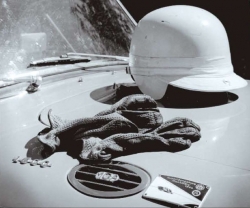
 In this article, kindly provided to us by the MG Owners’ Club, Malcolm Green looks back at the MG scene of 50 years ago. In 1960, the MGA was already available with 1500, 1600, and Twin Cam engines, in roadster and coupe form. The Magnette saloon was 7 years old, and was in its Mark III guise.
In this article, kindly provided to us by the MG Owners’ Club, Malcolm Green looks back at the MG scene of 50 years ago. In 1960, the MGA was already available with 1500, 1600, and Twin Cam engines, in roadster and coupe form. The Magnette saloon was 7 years old, and was in its Mark III guise.
This article is one of a series by Malcolm Green, and was first published in the March 2010 editiion of MGOC’s Enjoying MG magazine. The periodic photographs in this article include shots of the Abingdon assembly line, advertising brochures and racing action. (Malcolm Green is also the author of the excellent MGA Restoration Guide published by Brooklands Books, ISBN 1-85520-302-2)
It hardly seems possible that we are now entering the second decade of the new millennium and that it is over ten years since we were warned about the possible meltdown of computer systems unable to cope with the change of century. It is also sobering to reflect that in a club where many of us still use MGBs and Midgets as everyday transport that both models were designed more than fifty years ago. Although the MGB was not launched until 1962, by 1960 the design process was well underway and prototypes were being built. The Midget was already on the road, albeit only in the form of the Mark I Austin•Healey Sprite. Even though far too many of us can remember that period very well, perhaps we should take the time when we are starting a new decade as an opportunity to look back at the MG scene half a century ago.
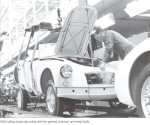 For the previous thirty years the Abingdon factory had been a centre for sports cars assembly and by 1960 was the largest producer in the world of these vehicles. Just before Christmas 1959 the factory celebrated a new record, the building that year of fifty thousand sports cars. However, the economic climate was changing, especially in their main American market where there was a recession, and in 1960 sales there of BMC sports cars was nearly halved. A look at the figures for LHD MGAs built for that market reveals the problem. In 1959 a total of nearly nineteen thousand 1500, 1600 and Twin Cam coupes and roadsters went to the USA and all found willing buyers. In 1960 the total fell to thirteen thousand and dealers still held unsold stock at the end of the year, resulting in even fewer still being exported in 1961. In Britain, financial circumstances still meant that for many it was a prewar MG that served as everyday transport and a popular conversion then was to fit a side valve Ford E93A engine in place of a worn-out OHC unit and magazines like Practical Motorist gave step-by step instructions on carrying out such modifications. Now decried as sacrilege, this did at least keep on the road many a car that might otherwise have ended up as scrap metal.
For the previous thirty years the Abingdon factory had been a centre for sports cars assembly and by 1960 was the largest producer in the world of these vehicles. Just before Christmas 1959 the factory celebrated a new record, the building that year of fifty thousand sports cars. However, the economic climate was changing, especially in their main American market where there was a recession, and in 1960 sales there of BMC sports cars was nearly halved. A look at the figures for LHD MGAs built for that market reveals the problem. In 1959 a total of nearly nineteen thousand 1500, 1600 and Twin Cam coupes and roadsters went to the USA and all found willing buyers. In 1960 the total fell to thirteen thousand and dealers still held unsold stock at the end of the year, resulting in even fewer still being exported in 1961. In Britain, financial circumstances still meant that for many it was a prewar MG that served as everyday transport and a popular conversion then was to fit a side valve Ford E93A engine in place of a worn-out OHC unit and magazines like Practical Motorist gave step-by step instructions on carrying out such modifications. Now decried as sacrilege, this did at least keep on the road many a car that might otherwise have ended up as scrap metal.
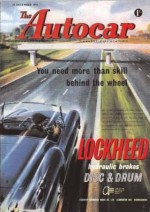 Looking at the world outside of MGs, in Britain a Conservative government had been elected to office the previous year and leader, Harold Macmillan undertook a tour of Africa to visit what were then British colonies. In Accra he delivered his now famous ‘wind of change’ speech, repeating this the following month, and attracting far greater attention, when speaking in Cape Town. It was to be a dramatic year in South Africa with the Sharpville massacre in March and the following month an assassination attempt on their prime minister, Henrick Verwoerd. Elsewhere a portent of troubles to come was the announcement by America of the dispatch of 3,500 troops to Vietnam. In November John F. Kennedy was elected as the youngest president of that country at a time when the cold war was at its height and Russia was making the most of having downed a U2 spy plane and captured its pilot, Gary Powers. On a lighter note, in Britain Penguin Books had been found not guilty of obscenity for publishing Lady Chatterley’s Lover and the first episode of Coronation Street was screened.
Looking at the world outside of MGs, in Britain a Conservative government had been elected to office the previous year and leader, Harold Macmillan undertook a tour of Africa to visit what were then British colonies. In Accra he delivered his now famous ‘wind of change’ speech, repeating this the following month, and attracting far greater attention, when speaking in Cape Town. It was to be a dramatic year in South Africa with the Sharpville massacre in March and the following month an assassination attempt on their prime minister, Henrick Verwoerd. Elsewhere a portent of troubles to come was the announcement by America of the dispatch of 3,500 troops to Vietnam. In November John F. Kennedy was elected as the youngest president of that country at a time when the cold war was at its height and Russia was making the most of having downed a U2 spy plane and captured its pilot, Gary Powers. On a lighter note, in Britain Penguin Books had been found not guilty of obscenity for publishing Lady Chatterley’s Lover and the first episode of Coronation Street was screened.
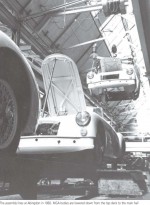 The line-up of MG models in 1960 comprised the MGA 1600 and Twin Cam models in roadster and coupe form and the Magnette Mark III saloon. However, the latter was not assembled at Abingdon. The fall in overseas sales obviously had an effect on running and manning the factory. In addition to the MGA, Abingdon assembled Austin-Healey the 3000 Mark I and Sprite, but to keep the workers fully employed also built a number of Morris 1000 vans and estate cars. The flexibility of the manual assembly line system used by MG made it easy to transfer production of any such more low volume vehicles at relatively short notice.
The line-up of MG models in 1960 comprised the MGA 1600 and Twin Cam models in roadster and coupe form and the Magnette Mark III saloon. However, the latter was not assembled at Abingdon. The fall in overseas sales obviously had an effect on running and manning the factory. In addition to the MGA, Abingdon assembled Austin-Healey the 3000 Mark I and Sprite, but to keep the workers fully employed also built a number of Morris 1000 vans and estate cars. The flexibility of the manual assembly line system used by MG made it easy to transfer production of any such more low volume vehicles at relatively short notice.
The MGA had been introduced in 1955 and had proved to be the company’s most popular model to date. Retaining a separate chassis developed from previous models it was relatively complicated and more expensive to build than monocoque vehicles. The Twin Cam model introduced in 1958 had been a brave attempt to produce a more highly developed version for use both on the road and in competition. Because of poor engine development it initially earned a reputation for unreliability and although the shortcomings were ironed out by 1960 sales did not warrant its continuation and it was quietly dropped from the range early in the year.
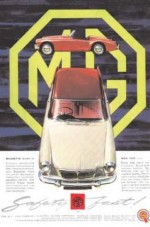 Improvements to the MGA had been made in the middle of 1959 and these included enlarging the B-series engine capacity from 1,489cc to 1,588cc and adopting disc brakes for the front wheels. The Twin Cam had been given discs for all four wheels but this was considered to be unnecessarily complicated and expensive for the standard model. Along with the mechanical changes came a new range of colour schemes and revised light clusters. In the home market a new MGA 1600 roadster cost £663, plus £277 7s 6p purchase tax, and the revised model proved popular with encouraging initial sales at home and overseas. However, when selling to people looking more for style and convenience than out and out sporting performance, things like removable side screens and limited cockpit space matter. The introduction of sports cars with roomier cabins and proper winding windows, like the Sunbeam Alpine, were beginning to have an effect in the showroom and at Abingdon they wanted to get the replacement MGB into production as soon as possible. In the event it was to be launched towards the end of 1962 and in the meanwhile in 1961 a further revision of the MGA was introduced in an attempt to maintain sales volumes.
Improvements to the MGA had been made in the middle of 1959 and these included enlarging the B-series engine capacity from 1,489cc to 1,588cc and adopting disc brakes for the front wheels. The Twin Cam had been given discs for all four wheels but this was considered to be unnecessarily complicated and expensive for the standard model. Along with the mechanical changes came a new range of colour schemes and revised light clusters. In the home market a new MGA 1600 roadster cost £663, plus £277 7s 6p purchase tax, and the revised model proved popular with encouraging initial sales at home and overseas. However, when selling to people looking more for style and convenience than out and out sporting performance, things like removable side screens and limited cockpit space matter. The introduction of sports cars with roomier cabins and proper winding windows, like the Sunbeam Alpine, were beginning to have an effect in the showroom and at Abingdon they wanted to get the replacement MGB into production as soon as possible. In the event it was to be launched towards the end of 1962 and in the meanwhile in 1961 a further revision of the MGA was introduced in an attempt to maintain sales volumes.
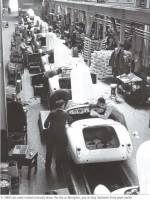 It was a blow for both the Abingdon workforce and for the customers that when production of the successful ZA/ZB range of sports saloons ceased the replacement was a badge engineered version of the Farina-designed Austin/Morris family saloon that, unlike the outgoing cars, were built elsewhere. Economics dictated that with the ever increasing cost of designing and producing new models these had to be sold in the largest possible number. The British Motor Corporation had inherited a large number of marque names and existing arrangements with the various dealer networks meant that they felt they needed to perpetuate these by making Wolseley, Riley, Austin, Morris and MG versions of what was basically the same vehicle. Imagine the extra costs involved in producing not just all the different grilles, badges, type of trim and modified body panels required by this strategy, but also five different sales catalogues, parts books, drivers’ handbooks, etc. It is no wonder the company were unable to compete with the likes of Ford.
It was a blow for both the Abingdon workforce and for the customers that when production of the successful ZA/ZB range of sports saloons ceased the replacement was a badge engineered version of the Farina-designed Austin/Morris family saloon that, unlike the outgoing cars, were built elsewhere. Economics dictated that with the ever increasing cost of designing and producing new models these had to be sold in the largest possible number. The British Motor Corporation had inherited a large number of marque names and existing arrangements with the various dealer networks meant that they felt they needed to perpetuate these by making Wolseley, Riley, Austin, Morris and MG versions of what was basically the same vehicle. Imagine the extra costs involved in producing not just all the different grilles, badges, type of trim and modified body panels required by this strategy, but also five different sales catalogues, parts books, drivers’ handbooks, etc. It is no wonder the company were unable to compete with the likes of Ford.
MG had built a solid reputation with their sporting saloons. Pre-war there had been closed versions of most models and in the 1940s and 1950s the Y•type and Z-Magnettes had built up a loyal following. Effectively abandoning this market segment was to prove a mistake as during the years after 1960 there emerged a number of performance versions of saloons that were to prove very successful. Ford had the GT and Lotus models of the very successful and profitable Cortina, the Mini-Cooper became very popular and in the 1970s we saw the emergence of cars like the VW Golf GTI. The traditional sports car was no longer the first choice for those seeking extra performance.
However, in 1960 those worries were for the future and the average owner of an MGA or Sprite, as well as the many still using pre-war OHC models and all the T-series MGs, enjoyed roads that were far less crowded than they were to become fifty years later and a there was the freedom to participate in motor sport at reasonable cost. Car club half-night and full-night rallies using country lanes and finishing with a ‘nosh-up’ at some all-night venue were a regular feature and these could be enjoyed by anyone with car, map and willing navigator. There certainly was not the wide gulf between the ordinary showroom model and factory rally cars that now exists. The works cars were better prepared and had improved backing from service crews, but in 1960 differed little mechanically from standard.
 A look at contemporary magazines reveals a wide range of accessories designed for the amateur competitor. Whereas now one might rely on a satellite navigation system to find your position the Ordnance Survey one-inch maps were then the norm. Squares of plastic marked with a grid, usually called romers, were popular and widely advertised. These were used to identify a six-figure grid reference on the map and are still in use. Also very available was additional illumination for night events. Map reading lights on flexible stalks were popular both with competitors and those wanting to make their bog-standard car look more sporting. Where instrument lighting was insufficient to read the odometer easily one could buy from the makers of the romer a small bulb to provide extra light that was attached to the instrument glass with a rubber sucker. For reading signposts external swiveling lamps mounted to screen pillars had long been popular, but also available were some that could be stuck to the inside of the windscreen, meaning that one didn’t have to open the side window on a cold night to operate them.
A look at contemporary magazines reveals a wide range of accessories designed for the amateur competitor. Whereas now one might rely on a satellite navigation system to find your position the Ordnance Survey one-inch maps were then the norm. Squares of plastic marked with a grid, usually called romers, were popular and widely advertised. These were used to identify a six-figure grid reference on the map and are still in use. Also very available was additional illumination for night events. Map reading lights on flexible stalks were popular both with competitors and those wanting to make their bog-standard car look more sporting. Where instrument lighting was insufficient to read the odometer easily one could buy from the makers of the romer a small bulb to provide extra light that was attached to the instrument glass with a rubber sucker. For reading signposts external swiveling lamps mounted to screen pillars had long been popular, but also available were some that could be stuck to the inside of the windscreen, meaning that one didn’t have to open the side window on a cold night to operate them.
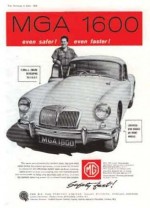 The Society of Motor Manufacturers and Traders, at the time a powerful body having what seems to have been the sole aim of protecting the major car builders from competition or unnecessary expense, had long imposed a ban on makers of racing cars or competition equipment attending the London Motor Show. In January 1960 the British Racing and Sports Car Club held the first London Racing Car Show at the Old Horticultural Halls in Westminster. The idea for the event came from the BRSCC Treasurer, Ian Smith who had seen that even the championship-winning Vanwall was not at the Earls Court show he visited in 1958. With co-organisers, Les Leston, Derek Newton and Nick Syrett he staged an event that was very popular with motor sport enthusiasts and was to continue in the same format for many years. In addition to having on display the cars that had been successful over the previous season, manufacturers of complete racing cars, tuning equipment and other necessities took the opportunity to sell their products at the show. In 1960 Lotus launched their new, rear-engine Formula Junior car and also present for the same category were the products from Elva, Cooper and Lola. Potential entrants could therefore examine the latest cars all gathered together under the same roof before deciding which to buy. The BMC A•series engine as used for the Midget Sprite was at the time predominant in the formula.
The Society of Motor Manufacturers and Traders, at the time a powerful body having what seems to have been the sole aim of protecting the major car builders from competition or unnecessary expense, had long imposed a ban on makers of racing cars or competition equipment attending the London Motor Show. In January 1960 the British Racing and Sports Car Club held the first London Racing Car Show at the Old Horticultural Halls in Westminster. The idea for the event came from the BRSCC Treasurer, Ian Smith who had seen that even the championship-winning Vanwall was not at the Earls Court show he visited in 1958. With co-organisers, Les Leston, Derek Newton and Nick Syrett he staged an event that was very popular with motor sport enthusiasts and was to continue in the same format for many years. In addition to having on display the cars that had been successful over the previous season, manufacturers of complete racing cars, tuning equipment and other necessities took the opportunity to sell their products at the show. In 1960 Lotus launched their new, rear-engine Formula Junior car and also present for the same category were the products from Elva, Cooper and Lola. Potential entrants could therefore examine the latest cars all gathered together under the same roof before deciding which to buy. The BMC A•series engine as used for the Midget Sprite was at the time predominant in the formula.
Turning to the exploits of the professional competitors, in 1960 the Abingdon BMC Competition Department was kept very busy. In January there was the Monte Carlo Rally where no fewer than six of the new Austin Mini-Minors and Austin Sevens were entered. In the same month for the second time the Competitions Department provided a team of three Twin Cam MGAs for the Sebring twelve-hour race. There were drivers from America and Canada for two of the cars, whilst Ted Lund and Colin Escott, both experienced English racers, manned the third. The cars ran with aluminium hard tops fitted and were more heavily modified as regards equipment than was the case with the cars entered the previous year.
In the race the MGs did not fare well. The car with the British crew suffered valve gear problems and retired, whilst the other cars had repeated fractures of their brake pipes that lost them a considerable amount of time. This was attributed to the bumpy track, but it is also possible that the pipes themselves may have been at fault. The two MGAs running at the finish were placed third and fourth in class. For the remainder of the year efforts within the department were concentrated on the Mini and the Austin-Healey 3000, but for the German Rally in September they fielded an MGA 1600 for Peter Riley and Tony Ambrose who managed a creditable second place in class.
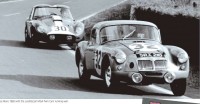 Three MGA prototypes had run at Le Mans in 1955 but after the disastrous crash that year official BMC participation stopped and the MG baton passed to what were private entries. In 1959 the enthusiastic Ted Lund decided he would like to enter again and obtained a lightweight body of the type used for the 1955 cars and, with much help from Abingdon, this was mated to a 1959 Twin Cam chassis fitted with a close-ratio gearbox and a 4.1: 1 rear axle. The car was entered in the name of the MG Car Club, North Western Centre and Ted’s co-driver was again Colin Escott.
Three MGA prototypes had run at Le Mans in 1955 but after the disastrous crash that year official BMC participation stopped and the MG baton passed to what were private entries. In 1959 the enthusiastic Ted Lund decided he would like to enter again and obtained a lightweight body of the type used for the 1955 cars and, with much help from Abingdon, this was mated to a 1959 Twin Cam chassis fitted with a close-ratio gearbox and a 4.1: 1 rear axle. The car was entered in the name of the MG Car Club, North Western Centre and Ted’s co-driver was again Colin Escott.
For the drivers of the sole MG, the 1959 race started well enough with the car performing to plan. If the car stayed reliable, there was every chance that they could put up a very creditable performance against others in their class. However, fate intervened at the end of the Mulsanne straight in the shape of a stray Alsatian dog, which the MG hit at high speed. The car was seriously damaged and the dog was in an even worse state. In the pits some hasty repairs were carried out but distortion of the front of the body affected the airflow through the radiator and this eventually caused the engine to overheat and expire.
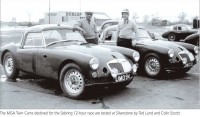 Ted returned in 1960 with the repaired car converted to a coupe and with steel front wings replacing the damaged aluminium ones. MGA coupe doors with Perspex side windows had been fitted and the roof was neatly blended into a fixed, sloping rear section. The twin-cam engine installed was bored out from 1,588cc to 1,762cc, taking the car into the less hotly contested two-litre class. Practice was wet, but the race started in the dry and the MG crew soon settled down to complete each lap in around 5mins. 10 sec., about 95 mph. Unfortunately, heavy rain set in on the Saturday night and this revealed the only serious fault on the car, when the wipers started misbehaving. In the end they had to make two pit stops to effect a partial cure. These cost the team around ten minutes, and the poor wiper performance during the storms must have affected their average speeds. Nevertheless, once the rain stopped, co-driver, Colin Escott did manage a fastest lap of 99.46 mph and the rest of the race ended without further drama. The car was placed first in class, averaging 91.12 mph, and took twelfth position in the overall classification.
Ted returned in 1960 with the repaired car converted to a coupe and with steel front wings replacing the damaged aluminium ones. MGA coupe doors with Perspex side windows had been fitted and the roof was neatly blended into a fixed, sloping rear section. The twin-cam engine installed was bored out from 1,588cc to 1,762cc, taking the car into the less hotly contested two-litre class. Practice was wet, but the race started in the dry and the MG crew soon settled down to complete each lap in around 5mins. 10 sec., about 95 mph. Unfortunately, heavy rain set in on the Saturday night and this revealed the only serious fault on the car, when the wipers started misbehaving. In the end they had to make two pit stops to effect a partial cure. These cost the team around ten minutes, and the poor wiper performance during the storms must have affected their average speeds. Nevertheless, once the rain stopped, co-driver, Colin Escott did manage a fastest lap of 99.46 mph and the rest of the race ended without further drama. The car was placed first in class, averaging 91.12 mph, and took twelfth position in the overall classification.
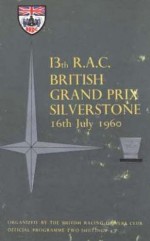 Then, as now, those unable to afford the price of a new MG looked to the second-hand market and at the time The Autocar regularly published tests of such vehicles. In August 1960 they took a 1957 MGA 1500 roadster that was being sold by Eaton Motor Company of Eaton Socon, St. Neots, Huntingdonshire for £595 and reported on both its performance and condition. What is immediately obvious is how much less durable were cars of that period when compared to modern products. Despite what was then a high price for a three-year-old car, the condition of the red paintwork, described as being faded and scratched with rust appearing on the sills and elsewhere, and of the worn interior was typical of most used sports cars of that age. The testers commented that they found that such cars were usually in no better condition cosmetically than ordinary family saloons, but were often better maintained mechanically.
Then, as now, those unable to afford the price of a new MG looked to the second-hand market and at the time The Autocar regularly published tests of such vehicles. In August 1960 they took a 1957 MGA 1500 roadster that was being sold by Eaton Motor Company of Eaton Socon, St. Neots, Huntingdonshire for £595 and reported on both its performance and condition. What is immediately obvious is how much less durable were cars of that period when compared to modern products. Despite what was then a high price for a three-year-old car, the condition of the red paintwork, described as being faded and scratched with rust appearing on the sills and elsewhere, and of the worn interior was typical of most used sports cars of that age. The testers commented that they found that such cars were usually in no better condition cosmetically than ordinary family saloons, but were often better maintained mechanically.
On the road the MGA still gave good performance with acceleration figures not far short of those recorded for the model when new and the car was capable of cruising at 80mph when conditions allowed. Remember that there was no overall speed limit then and the M1 motorway had opened the previous year. What did produce favourable comment was that the second-hand vehicle retained the overall stability and good roadholding that so characterizes the model. Reading the report now one can only envy the 1960 owners of what was then one of the nicest sports cars to own and drive, especially at a time when the performance car motorist was not seen as an enemy of society and a threat to the future of the planet. By nature, those of us who maintain and drive old cars are necessarily sympathetic to the past, but despite all the many products and services that have since 1960 become an integral part of our everyday lives perhaps the world for the motoring enthusiast will never seen quite as good as was then.


Comment by: GTP Motorsports
Thanks on your marvelous posting! I definitely enjoyed reading it, you may be a great author. I will remember to bookmark your blog and will come back very soon. I want to encourage that you continue your great writing, have a nice weekend!
Comment by: Peter & Anne Tilbury
Hi Mary,
Thank you for your comment.
Your 1958 MGA could be worth between $2000 and $30,000, depending on condition. You can get a better idea of the value by contacting a NAMGAR Chapter Club in your area. Check out the listings on the NAMGAR web site.
Also to advertise your car for sale, contact advertising@namgar.com. The advert is free for NAMGAR members. You can become a NAMGAR member by applying through the web site to registrar@namgar.com. The cost is US$37.50 for one year.
Hope this is helpful to you.
Comment by: Mary Wynn
I really enjoyed reading this article on the MGs. I have a 1958 MGA and I have decided to put it up for sale. Can anyone give me an idea on the value?